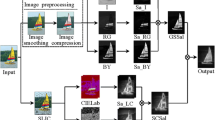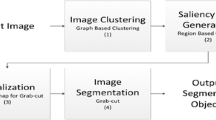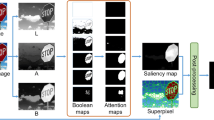Abstract
In this study, we propose to detect regions of interest based on salient information in images. The maximally stable color region (MSCR) approach is extended by incorporating color salient information into the stable region detection design. Salient regions with a color similar to that of their vicinity are detected successively through agglomerative clustering. The algorithm introduces novel methods used in color saliency enhancement into the context of local feature detection. The color saliency enhancement approach is evaluated by detecting salient objects. Experimental results demonstrate that our algorithm yields high precision and recall rates, and focuses on the interesting color structure of the image. The proposed detector is also evaluated by using an image matching test. The experimental results show that this detector outperforms intensity- and color-based detectors in terms of match correspondence.







Similar content being viewed by others
References
(2005) Web-site. http://www.robots.ox.ac.uk/~vgg/research/affine/
Abdel-Hakim AE, Farag AA (2006) CSIFT: a SIFT descriptor with color invariant characteristics. In IEEE Conference on Computer Vision and Pattern Recognition, New York, USA, pp 1978–1983
Achanta R, Hemami S, Estrada F, Süsstrunk S (2009) Frequency-tuned Salient Region Detection. In: Proc. 2009 I.E. Int. Conf. Computer Vision and Pattern Recognition, Miami, pp 1597–1604
Ballan L, Bertini M, Bimbo AD et al (2010) Video event classification using string kernels. Multimed Tools Appl 48(1):69–87
Bay H, Tuytelaars T, Van Gool L (2006) SURF: speeded up robust features. In 9th European Conference on Computer Vision
Borji A, Itti L (2013) State-of-the-art in visual attention modeling. IEEE Trans Pattern Anal Mach Intell 35(1):185–207
Cheng MM, Mitra NJ, Huang X, Hu SM (2013) SalientShape: group saliency in image collections. The Visual Computer, pp 1-11
Forssen P (2007) Maximally stable colour regions for recognition and matching. In: Proc. 2007 I.E. Int. Conf. Computer Vision and Pattern Recognition, Minneapolis, USA, pp 1–8
Geusebroek JM, Burghouts GJ, Smeulders AWM (2005) The Amsterdam library of object images. Int J Comput Vis 61(1):103–112
Goferman S, Zelnik-Manor L, Tal A (2010) Context-aware saliency detection. In CVPR, pp 2376–2383
Harel J, Koch C, Perona P (2007) Graph-based visual saliency. Adv Neural Inf Process Syst 19:545
Harris C, Stephens M (1988) A combined corner and edge detector. In Alvey Vision Conference, pp 147–151
Heiler M, Schnorr C (2005) Natural image statistics for natural image segmentation. Int J Comput Vis 63(1):5–19
Itti L, Koch C, Niebur E (2001) Computation modeling of visual attention. Nat Rev Neurosci 2(3):194–203
Khan F, Anwer R, van de Weijer J, Bagdanov A, Vanrell M, Lopez A (2012) Color attributes for object detection. In proceeding of Computer Vision and Pattern Recognition (CVPR), 2012 IEEE Conference on, pp 3306–3313
Lowe DG (2004) Distinctive image features from scale-invariant keypoints. Int J Comput Vis 60(2):91–110
Matas J, Chum O, Urban M, Pajdla T (2002) Robust wide baseline stereo from maximally stable extremal regions. In: Proc. British Machine Vision Conference, Cardiff, pp 384–393
Mikolajczyk K, Schmid C (2005) A performance evaluation of local descriptors. IEEE Trans Pattern Anal Mach Intell 27(10):1615–1630
Penas M, Shapiro LG (2009) A color-based interest operator. In: Proc. Int. Conf. Image Analysis and Processing, pp 5716: 965–974
Pouli T, Cunningham DW, Reinhard E (2011) A survey of image statistics in computer graphics. Comput Graph Forum 30:1–25
Qu Y, Wu S, Liu H, Xie Y, Wang H (2012) Evaluation of local features and classifiers in BOW model for image classification. Journal of Multimedia Tools and Applications. doi:10.1007/s11042-012-1107-z
Srivastava A, Lee AB, Simoncelli EP, Zhu SC (2003) On advances in statistical modeling of natural images. J Math Imaging Vis 18(1):17–33
Unnikrishnan R, Hebert M (2006) Extracting scale and illuminant invariant regions through colour, In: Proc. British Machine Vision Conference, Edinburgh
van de Weijer J, Gevers T, Bagdanov A (2006) Boosting color saliency in image feature detection. IEEE Trans Pattern Anal Mach Intell 28(1):150–156
Vigo DR, van de Weijer J, Gevers T (2010) Color edge saliency boosting using natural image statistics. In Proc. CGIV 228–234
Wolfe JM, Horowitz TS (2004) What attributes guide the deployment of visual attention and how do they do it? Nat Rev Neurosci 5:495–501
Acknowledgments
This work was supported by the National Natural Science Foundation of China (No. 61263046, 61063030), Aviation Science Foundation of China (No. 2010ZC56005).
Author information
Authors and Affiliations
Corresponding author
Rights and permissions
About this article
Cite this article
Miao, J., Chu, J. & Zhang, G. Detection of saliency maximally stable color regions. Multimed Tools Appl 74, 5845–5860 (2015). https://doi.org/10.1007/s11042-014-1893-6
Published:
Issue Date:
DOI: https://doi.org/10.1007/s11042-014-1893-6




